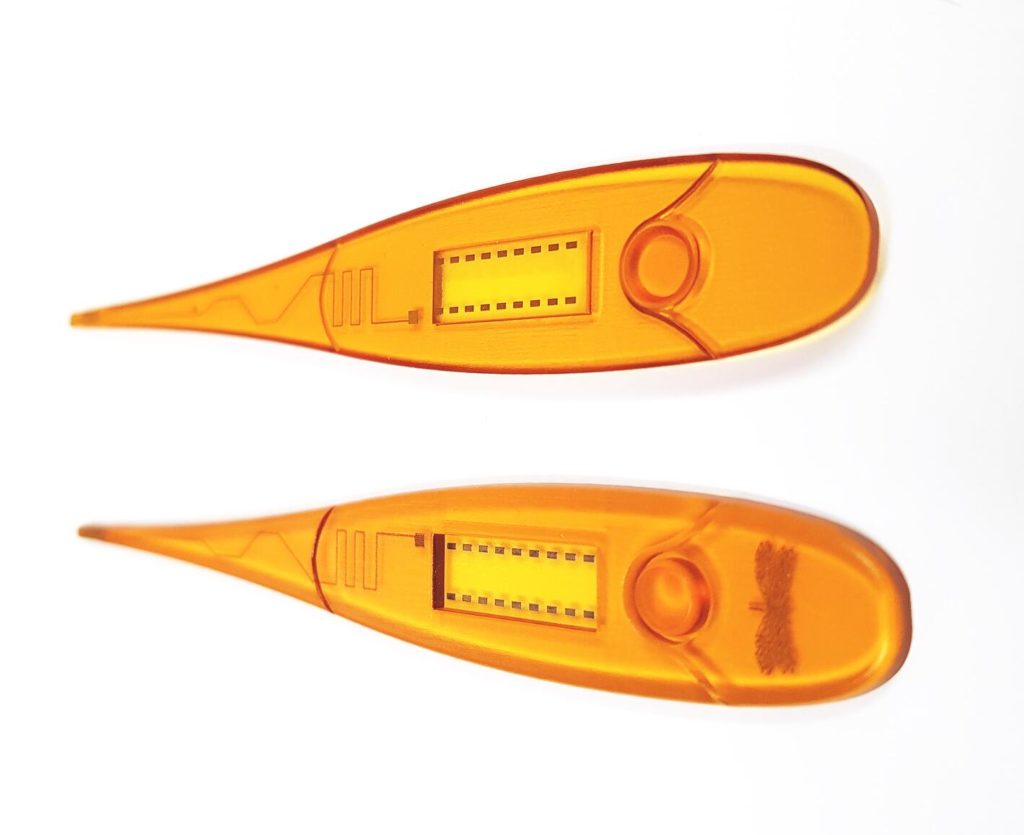In our previous articles in this series, we discussed the history leading up to the development of electronics 3D printing, as well as one of the two dominant methods for printing electronics, direct writing. The other leading method for 3D printing electronics is inkjetting.
Inkjetting processes deposit photopolymers similar to a printhead found in 2D printers before curing them using ultraviolet light. The most notable company working with this process is NanoDimension, an Israeli company that has developed the DragonFly series of PCB 3D printers.
The DragonFly series jets conductive inks alongside a photocurable, dielectric ink. The process by printing bottom solder masks and pads, then printing and sintering conductive layers and printing and curing the dielectric layers, and then ending with the top solder masks and pads. The dielectric ink is cured with an LED lamp, while the conductive ink is sintered by an internal energy source.
Auxiliary electronics, including transistors and resistors, can then be added to prototype PCB designs, including multilayer PCBs. The company has demonstrated a number of applications, including embedded electronics, electromagnets, molded interconnect devices, antennas and sensors.
Like NanoDimension, ChemCubed inkjets dielectric photopolymer alongside conductive silver ink. The company’s flagship product is the ElectroJet, an LED flatbed 3D printer designed through a collaboration Direct Color Systems. Because Direct Color Systems offers UV printing machines—for Braille and textured signage, phone cases, acrylic awards and other applications— with build areas up to 600mm x 1,200mm in size, it’s possible that ChemCubed could scale up the size of its system to even enable batch additive production of PCBs.
A Boston startup with exciting potential is Inkbit, which is commercializing technology developed at MIT that combines inkjet technology with machine vision and learning to 3D print multi-component objects. The vision system scans each layer with micrometer resolution as the ink is deposited, registering any discrepancies between the print and the CAD geometry and compensating. This means that the internal roller required for evening layers in traditional inkjet systems, is unnecessary, allowing for the use of materials that would not jam these conventional types of systems. Meanwhile, the machine learning software behind Inkbit’s process is able to learn from errors that occur within prints and improve over time.
The machine vision system makes it possible to also incorporate additional parts into printed objects. To do this, the printer is paused and these items, such as metal reinforcement or electronics, can be manually inserted before the print begins and material is printed around them. At MIT’s Computer Science and Artificial Intelligence Laboratory, where the technology was developed, researchers demonstrated the ability to 3D print complex lenses, micro lens arrays, fiber-optic bundles, complex meta materials, an object with a built-in razor blade, lenses on top of LEDs, and even a plastic smartphone case around an existing smartphone. While the incorporation of these elements is currently performed manually, the company is hoping that, in the future, the Inkbit system can be brought into a production line where pick and place machines can add these components automatically.
Inkbit’s technology demonstrates the potential future of electronics 3D printing, having already tackled the ability to fabricate complete, functional objects with a single build process, though there is are a number of hurdles to overcome, not the least of which is automation. In our next post in the series, we will look at the myriad research endeavors currently being pursued to expand the capabilities of present electronics 3D printing technology.
Subscribe to Our Email Newsletter
Stay up-to-date on all the latest news from the 3D printing industry and receive information and offers from third party vendors.
You May Also Like
Boom Supersonic Test Flies Demonstrator Aircraft
Boom Supersonic hopes to revolutionize air travel by reintroducing supersonic passenger flights. The company has amassed over $700 million in funding, with notable contributions from entities like Japan Airlines, and...
Conglomerates Are Auctioning GE Metal 3D Printers and More
As the additive manufacturing (AM) industry continues to slough through its economic downturn, we’ve seen not only smaller firms like Uniformity Labs and Arevo go belly up, but larger entities restructuring in...
Interview: GE Additive Provides Series 3 Metal Binder Jet Update
For another year running, I survived the bustling insanity that is formnext. With a reported 859 exhibitors, 196 speakers, 32,851 visitors (50% international), and 54,000 m² of exhibition space, Europe’s...
Del Toro’s Pinocchio Achieves Stop-Motion First with Metal 3D Printed Metal Puppets
Did you know that the stop-motion puppetry featured in Guillermo del Toro’s 2022 film Pinocchio was accomplished through the use of metal 3D printing? Our story begins in the year...






























